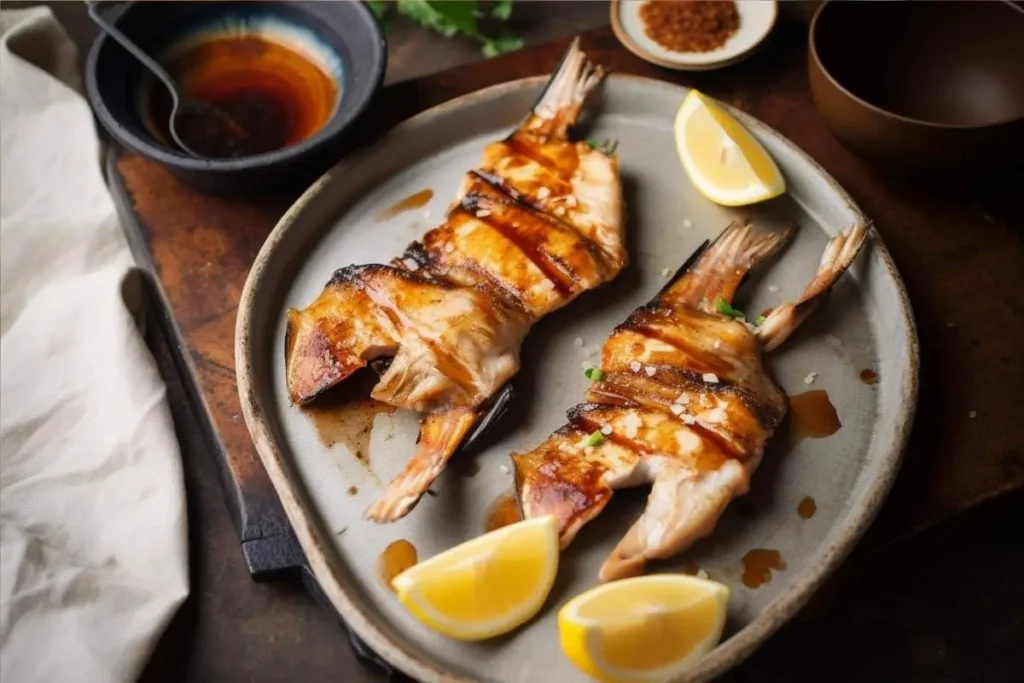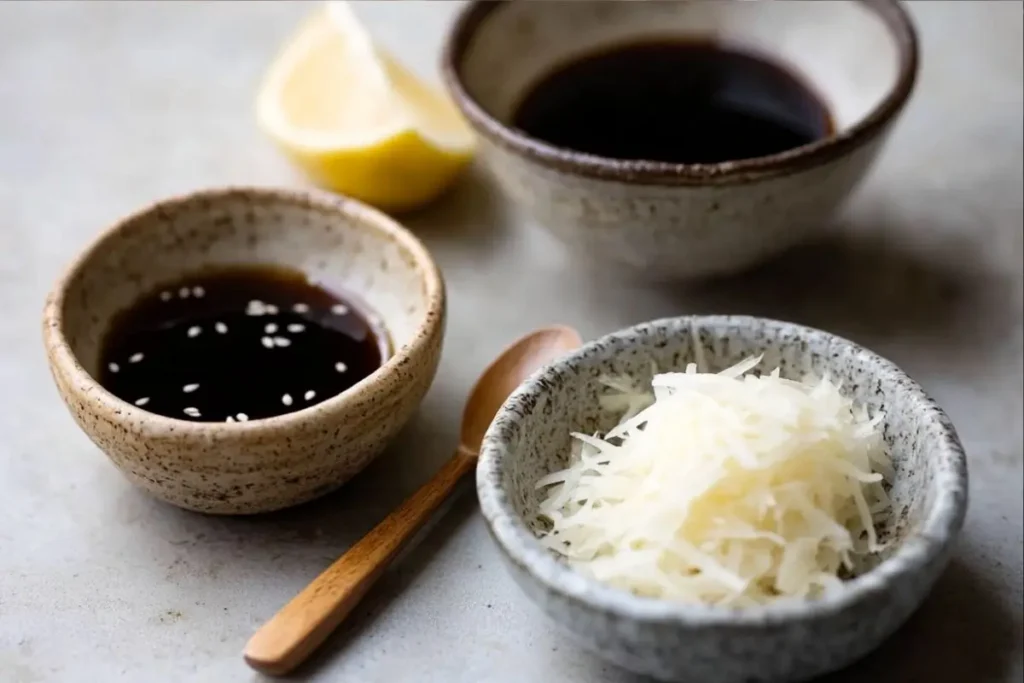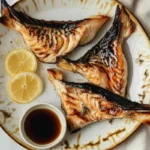If you love Japanese cuisine, you might have enjoyed popular dishes like sushi, sashimi, or grilled unagi. But have you ever tried salmon kama? This hidden gem is one of the most flavorful and tender parts of the fish, yet it remains relatively unknown outside of Japan.
The collar cut of salmon, known as kama, is the small, fatty section right behind the head. It’s incredibly rich in flavor, with a melt-in-your-mouth texture that rivals even the most expensive cuts of fish. Whether grilled to perfection or broiled with a savory soy-based glaze, this dish is a must-try for seafood lovers.
In this article, we’ll explore:
✔️ What makes this Japanese delicacy so special
✔️ The best cooking methods for achieving crispy skin and juicy meat
✔️ Traditional seasonings and marinades
✔️ Side dishes and sauces that pair perfectly with this dish
What is Salmon Kama?
The Unique Cut: What Makes Salmon Kama Special?
Not all fish cuts are created equal! While fillets and steaks get most of the attention, this overlooked section is an underrated treasure in the world of seafood. It’s the collar cut of salmon—the meaty section just behind the gills and under the head.
Why is this cut so special?
✔️ It’s incredibly fatty and tender, making it one of the juiciest parts of the fish.
✔️ The high oil content keeps it moist, even when grilled at high heat.
✔️ The crispy skin and buttery texture make it a true delicacy.
In Japanese cuisine, fish collars are highly prized. In fact, this section is often considered the best part of the fish, thanks to its rich flavor and delicate meat.
Salmon Kama vs. Other Fish Cuts: Why It’s the Best Kept Secret
If you’ve never had salmon kama, you might be wondering how it compares to other cuts:
- Fillet: Leaner and more commonly used, but lacks the same rich flavor.
- Belly: Another fatty cut, but tends to be softer and less structured.
- Tail: A firmer, leaner cut that requires careful cooking.
Unlike fillets, which can dry out easily, this cut stays juicy and flavorful, even with minimal seasoning. It’s also more affordable than premium fillets—so you get an amazing dining experience without the hefty price tag!
📌 Coming up next: Should you grill or broil this Japanese favorite for the best results?
Choosing the Best Salmon Kama
What is Salmon Kama?
Salmon kama refers to the collar of the fish, which is the fatty, tender part located just behind the gills. This cut is highly prized for its rich flavor and soft texture. Because of its high fat content, it becomes incredibly juicy when cooked properly.
How to Source the Best Salmon Kama
When buying salmon kama, freshness is key. Look for:
✔️ Bright, firm flesh with no discoloration.
✔️ A mild, ocean-fresh smell—avoid fish with a strong odor.
✔️ Sustainably sourced options like wild-caught Alaskan salmon.
Many Asian markets, fishmongers, and specialty seafood stores carry salmon collars. You can also ask your local grocery store’s seafood counter if they have extra collars available.
📌 Love exploring different cuts of fish? You might also enjoy making Salmon Crudo – Fresh & Easy No-Cook Recipe for another delicious way to enjoy salmon!
Best Cooking Methods for Salmon Kama
Should You Grill, Broil, or Pan-Sear?
Salmon kama is incredibly versatile, and you can cook it in several ways:
🔥 Grilling – The best method for achieving crispy skin and a smoky flavor.
🔥 Broiling – Perfect for a quick, easy, and charred finish.
🔥 Pan-searing – Ideal if you want a crispy crust without needing a grill.
How to Grill Salmon Kama Perfectly
Grilling is a top choice for salmon kama because it enhances the natural fattiness and creates an irresistible crispiness. Here’s how:
1️⃣ Preheat your grill to medium-high heat (about 400°F).
2️⃣ Lightly oil the grates to prevent sticking.
3️⃣ Season salmon kama with salt, pepper, and a touch of soy sauce.
4️⃣ Grill skin-side down for about 4-5 minutes, then flip and cook another 3-4 minutes.
5️⃣ The collar should be golden-brown and slightly crispy.
Broiling for an Easy, Flavorful Dish
If you don’t have a grill, broiling is a great alternative. Simply:
✅ Place salmon kama on a baking sheet lined with foil.
✅ Brush with a mix of soy sauce, garlic, and sesame oil.
✅ Broil for 6-8 minutes, flipping halfway for even crisping.
📌 Want more quick and delicious seafood recipes? Try this homemade Tuna Helper Recipe for a creamy, comforting dish!
How to Prepare Salmon Kama
Cleaning and Prepping the Fish
Before cooking salmon kama, proper cleaning and preparation are essential. Since the collar contains small bones and connective tissue, trimming and cleaning it properly ensures the best texture and flavor.
1️⃣ Rinse and Pat Dry – Gently rinse the salmon kama under cold water to remove any remaining blood or scales. Pat dry thoroughly with a paper towel.
2️⃣ Trim Excess Tissue – If needed, use a sharp knife to trim any excess fat, skin, or connective tissue that may affect the final texture. However, leaving some skin and fat enhances the juiciness of the final dish.
3️⃣ Scoring the Flesh (Optional) – Making small slits in the thickest parts of the collar allows for better absorption of seasonings and ensures even cooking.
Marinating for Maximum Flavor
While salmon kama is naturally rich and flavorful, marinating enhances its umami taste. A simple Japanese-style marinade balances richness with savory and citrusy elements.
🔹 Classic Marinade Recipe:
- 2 tbsp soy sauce
- 1 tbsp mirin (Japanese sweet rice wine)
- 1 tbsp sake
- 1 tsp grated ginger
- 1 clove garlic, minced
- ½ tsp sea salt
- ½ tsp toasted sesame oil
🕒 Marinating Time:
For the best results, let the salmon kama marinate for 30 minutes to 1 hour. This helps the flavors penetrate while keeping the texture firm and juicy. Avoid over-marinating, as the acidity in mirin and sake can break down the delicate flesh.
Best Cooking Methods for Salmon Kama
Salmon kama can be prepared using various cooking techniques, but the two best methods are grilling and broiling—both bring out its rich flavors while maintaining a crispy, slightly charred exterior.
Grilling: The Traditional Japanese Method
Grilling is the most authentic way to cook salmon kama. It enhances the smoky aroma while crisping up the skin and edges beautifully.

🔥 How to Grill Salmon Kama:
1️⃣ Preheat the Grill – Set your charcoal or gas grill to medium-high heat (375-400°F).
2️⃣ Oil the Grates – Lightly brush the grates with oil to prevent sticking.
3️⃣ Grill the Collar – Place the salmon kama skin-side down and grill for 5-7 minutes per side, or until the skin is crispy and the flesh is opaque.
4️⃣ Check for Doneness – The thickest part should reach 130-135°F for medium doneness.
✅ Pro Tip: Use binchotan charcoal (Japanese white charcoal) for an authentic smoky flavor!
Broiling: The Easy Oven Method
If you don’t have access to a grill, broiling is a fantastic alternative. It gives the salmon kama a crispy outer layer while keeping the inside juicy.
🔥 How to Broil Salmon Kama:
1️⃣ Preheat the Broiler – Set your oven to high broil (around 500°F).
2️⃣ Line a Baking Sheet – Use aluminum foil and lightly grease it with oil.
3️⃣ Arrange the Salmon – Place the collars skin-side up on the sheet.
4️⃣ Broil for 7-10 Minutes – Keep a close eye on the fish, as broiling cooks quickly! The skin should be golden brown and crispy.
Side Dishes and Pairings for Salmon Kama
Salmon kama is packed with rich, umami flavors, and the right side dishes can elevate it even further. Whether you want something light and fresh or bold and hearty, here are the best pairings for grilled or broiled salmon collar.
Light and Refreshing Side Dishes
Since salmon kama has a crispy exterior and buttery interior, pairing it with refreshing sides helps balance the flavors. Some excellent choices include:
- Steamed Rice or Sushi Rice – A simple bowl of Japanese short-grain rice absorbs the savory flavors of grilled salmon kama.
- Pickled Vegetables (Tsukemono) – Tangy pickled cucumbers, daikon, or ginger provide contrast and a palate cleanser.
- Miso Soup – A light and umami-packed miso soup complements the richness of salmon collar without overpowering it.
- Seaweed Salad – A slightly salty, sesame-infused seaweed salad brings a fresh ocean flavor to the dish.
For a well-balanced meal, try serving this Japanese favorite with a light, citrusy salad or a bowl of miso soup on the side.
📌 Want a delicious rice pairing? Try this Authentic Anjappar Egg Fried Rice for a bold and flavorful combination!
Bold and Hearty Pairings
If you’re looking for something more substantial, these side dishes add a bold contrast to the delicate salmon collar:
- Stir-Fried Vegetables – A mix of bell peppers, mushrooms, and bok choy stir-fried in garlic and soy sauce pairs beautifully.
- Japanese Potato Salad – Creamy, slightly sweet, and packed with flavor, this unique potato salad balances out the crispy texture of salmon kama.
- Spicy Cucumber Kimchi – A Korean-inspired side with a spicy kick that enhances the fatty richness of grilled salmon.
- Grilled Asparagus or Zucchini – Lightly charred vegetables with a drizzle of sesame oil make a perfect accompaniment.
Pairing salmon kama with these bold sides makes for a satisfying and well-rounded meal.
Salmon kama is an excellent source of omega-3 fatty acids, which are essential for brain health and reducing the risk of chronic diseases. Learn more about the science behind Omega-3s here.
Common Mistakes to Avoid When Cooking Salmon Kama
Even though salmon kama is a simple dish, there are some common mistakes that can affect the final result. Avoid these pitfalls to ensure a perfectly grilled or broiled salmon collar every time.
Choosing the Wrong Type of Salmon
Not all salmon collars are created equal! Some mistakes to avoid include:
❌ Using farmed salmon with low fat content – Wild-caught salmon has a richer flavor and firmer texture.
❌ Buying frozen, low-quality cuts – While frozen salmon can work, ensure it is sushi-grade and properly thawed.
❌ Not asking for collars at your local fish market – Many fishmongers don’t display salmon collars, so ask for them specifically.
Overcooking or Undercooking
Getting the timing right is essential. Here’s how to avoid ruining your salmon kama:
- Overcooking: Grilling or broiling too long dries out the fatty, tender meat. Cook each side for about 6 to 8 minutes over medium-high heat until the skin turns crispy and the flesh is tender.
- Undercooking: While slightly rare in the center is fine, ensure the skin crisps up and the flesh easily flakes off the bone.
- Not using high enough heat: A grill or broiler set to high ensures the skin crisps while the interior stays juicy.
Skipping the Marinade or Seasoning
Since salmon kama has a naturally rich flavor, seasoning mistakes can impact the dish:
- Not marinating: Even a quick soy sauce and citrus marinade enhances the flavors.
- Overpowering the natural taste: Too much seasoning can hide the delicate umami notes of the salmon.
- Skipping flaky sea salt: A sprinkle of salt before and after grilling enhances every bite.
By avoiding these mistakes, your salmon kama will turn out crispy, juicy, and packed with flavor every time!
📌 Want another easy dish? try this Crispy Chicken Tenders and Fries for an easy and satisfying meal!
What to Serve with Japanese Fish Collar
While salmon kama is delicious on its own, pairing it with the right sides and condiments enhances its flavors and creates a well-balanced meal. Whether you prefer something light and refreshing or bold and savory, here are the best options.

Best Condiments and Dipping Sauces
To elevate the taste of grilled or broiled salmon kama, try these traditional Japanese condiments:
- Ponzu Sauce – A tangy, citrusy soy sauce that adds brightness.
- Yuzu Kosho – A spicy, fermented citrus paste that complements the fatty richness of salmon collar.
- Wasabi & Soy Sauce – Adds a sharp, umami-packed bite.
- Grated Daikon Radish – A mild and refreshing garnish that balances the savory grilled fish.
- Togarashi (Japanese Seven-Spice) – Adds a subtle heat and depth of flavor.
Drizzle or dip your salmon kama in these condiments for an extra layer of complexity.
📌 If you love bold flavors, you might enjoy this Papas Locas – A Fun and Flavorful Loaded Potato Dish!
Ideal Side Dishes
Pairing salmon kama with complementary sides ensures a well-rounded dining experience. Here are some excellent choices:
- Steamed White or Brown Rice – A neutral base that absorbs the rich juices of the salmon.
- Japanese Pickles (Tsukemono) – Provides a crunchy, acidic contrast.
- Miso Soup – A light, savory soup that enhances the umami flavors.
- Crispy Tempura Vegetables – A crunchy, airy side that adds texture.
- Sautéed Garlic Spinach – A simple, flavorful vegetable pairing.
A well-thought-out combination of sides and sauces makes salmon kama even more enjoyable!
If you love crispy recipes, check out this Homemade Chicken Rings Recipe – A White Castle-Inspired Crunch! for another delicious option.
Conclusion
This traditional Japanese dish is a hidden gem in seafood cuisine, offering an unbeatable combination of crispy skin, tender meat, and rich umami flavor. Whether grilled, broiled, or lightly seasoned, it transforms into a restaurant-worthy dish in minutes.
Now that you know how to cook this delicious fish collar, pair it with the right condiments, and serve it with complementary sides, you’re ready to enjoy this delicacy anytime!
FAQs
What is salmon kama?
It’s the collar of the salmon, the fatty and tender section located behind the head.
What part of the fish is kama?
The kama is the collar, which includes the area behind the gills and pectoral fins. It contains a perfect balance of tender meat, crispy skin, and flavorful fat.
Are salmon collars good?
Absolutely! This flavorful cut is packed with healthy omega-3 fatty acids and offers a delicious balance of crispy skin and tender flesh.
What is kama in Japanese food?
In Japanese cuisine, kama refers to the collar cut of fish, commonly served grilled or broiled. It’s often found in izakayas (Japanese pubs) and high-end sushi restaurants due to its rich taste and texture.
Print
Salmon Kama Recipe
- Total Time: 25
- Yield: 4 1x
Description
A rich and flavorful Japanese salmon collar recipe prepared with two cooking methods: grilling for a smoky char or broiling for a crisp, caramelized glaze.
Ingredients
- 2 salmon collars
- 1 tbsp soy sauce
- 1 tsp sesame oil
- 1 tsp grated ginger
- 1 clove garlic, minced
- 1 tbsp mirin
- Lemon wedges, for serving
- Grated daikon radish, for garnish
Instructions
- Prepare Salmon Collars: Clean and pat dry the salmon collars. Trim any excess tissue for an even cook.
- Marinate: Mix soy sauce, sesame oil, grated ginger, garlic, and mirin in a bowl. Marinate the salmon collars for 30 minutes.
- Grill Method: Preheat grill to medium-high heat. Grill collars skin-side down for 5-7 minutes per side.
- Broil Method: Preheat broiler. Place collars on a baking sheet and broil for 6-8 minutes, flipping halfway.
- Serve: Garnish with grated daikon radish, lemon wedges, and optional ponzu sauce.
Notes
- Include alt text, captions, and descriptive titles for all images (see table shared earlier).
- Integrate external links naturally into the flow of the article text.
- Ensure smooth readability and visual appeal with well-placed media.
- Prep Time: 15
- Cook Time: 10
- Category: Lunch
- Cuisine: Japanese
Nutrition
- Serving Size: 1
- Calories: 250 kcal
- Sugar: 1 g
- Sodium: 500 mg
- Fat: 15 g
- Saturated Fat: 4 g
- Carbohydrates: 2 g
- Protein: 25 g
- Cholesterol: 50 mg
Keywords: salmon kama, grilled salmon collar, broiled salmon collar, Japanese recipes

